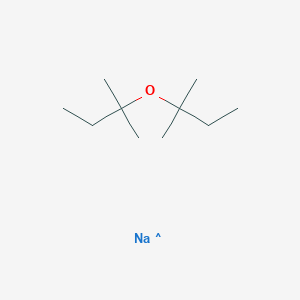
Sodium t-amyl oxide
- Haga clic en CONSULTA RÁPIDA para recibir una cotización de nuestro equipo de expertos.
- Con productos de calidad a un precio COMPETITIVO, puede centrarse más en su investigación.
Descripción general
Descripción
Sodium t-amyl oxide is a useful research compound. Its molecular formula is C10H22NaO and its molecular weight is 181.27 g/mol. The purity is usually 95%.
BenchChem offers high-quality this compound suitable for many research applications. Different packaging options are available to accommodate customers' requirements. Please inquire for more information about this compound including the price, delivery time, and more detailed information at [email protected].
Aplicaciones Científicas De Investigación
Organic Synthesis
Sodium t-amyl oxide serves as a strong base in organic reactions, facilitating the deprotonation of weak acids. This property is essential for forming carbon-carbon bonds, which are crucial in synthesizing complex organic molecules. Its role in organic synthesis can be summarized as follows:
Polymer Chemistry
In polymer chemistry, this compound is utilized to synthesize polyolefins, which are essential for producing plastics and elastomers with enhanced properties. Its applications include:
| Application | Description |
|---|---|
| Polymerization | Facilitates the polymerization process to create high-performance materials. |
| Material Properties | Enhances the mechanical and thermal properties of polymers . |
Pharmaceutical Development
This compound plays a critical role in pharmaceutical development by acting as a reagent in the synthesis of drug intermediates. Its applications include:
Analytical Chemistry
In analytical chemistry, this compound enhances the sensitivity and selectivity of assays, making it valuable for quality control processes. Its contributions include:
| Application | Description |
|---|---|
| Assay Enhancement | Improves detection limits and specificity in chemical analyses. |
| Quality Control | Used in various assays to ensure compliance with regulatory standards . |
Environmental Applications
This compound has potential applications in environmental remediation, particularly in breaking down hazardous substances through chemical reactions. Its role includes:
| Application | Description |
|---|---|
| Contaminant Remediation | Utilized to degrade pollutants in contaminated sites through chemical reactions . |
Case Study 1: Organic Synthesis
A study demonstrated the use of this compound in synthesizing complex molecules such as alkaloids and terpenes through deprotonation reactions that facilitated carbon-carbon bond formation.
Case Study 2: Pharmaceutical Development
Research highlighted this compound's effectiveness in synthesizing pharmaceutical intermediates for anti-inflammatory drugs, showcasing its importance in drug discovery and development processes.
Case Study 3: Environmental Remediation
An investigation into the use of this compound for remediating soil contaminated with heavy metals showed promising results, indicating its potential for breaking down toxic substances effectively.
Propiedades
Fórmula molecular |
C10H22NaO |
|---|---|
Peso molecular |
181.27 g/mol |
InChI |
InChI=1S/C10H22O.Na/c1-7-9(3,4)11-10(5,6)8-2;/h7-8H2,1-6H3; |
Clave InChI |
UIIJZQVROQHLAP-UHFFFAOYSA-N |
SMILES canónico |
CCC(C)(C)OC(C)(C)CC.[Na] |
Origen del producto |
United States |
Synthesis routes and methods I
Procedure details




Synthesis routes and methods II
Procedure details





Descargo de responsabilidad e información sobre productos de investigación in vitro
Tenga en cuenta que todos los artículos e información de productos presentados en BenchChem están destinados únicamente con fines informativos. Los productos disponibles para la compra en BenchChem están diseñados específicamente para estudios in vitro, que se realizan fuera de organismos vivos. Los estudios in vitro, derivados del término latino "in vidrio", involucran experimentos realizados en entornos de laboratorio controlados utilizando células o tejidos. Es importante tener en cuenta que estos productos no se clasifican como medicamentos y no han recibido la aprobación de la FDA para la prevención, tratamiento o cura de ninguna condición médica, dolencia o enfermedad. Debemos enfatizar que cualquier forma de introducción corporal de estos productos en humanos o animales está estrictamente prohibida por ley. Es esencial adherirse a estas pautas para garantizar el cumplimiento de los estándares legales y éticos en la investigación y experimentación.













